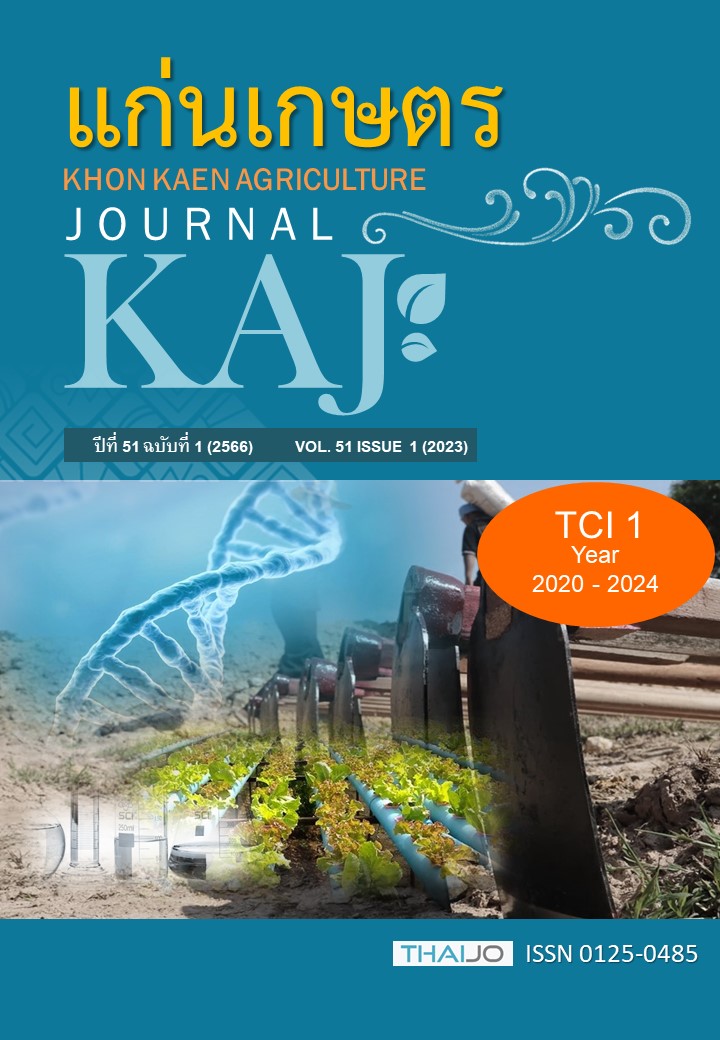การประยุกต์ใช้เทคโนโลยีการเรียนรู้เชิงลึกโดยโครงข่ายประสาทเทียมแบบคอนโวลูชัน เพื่อวินิจฉัยโรคในกุ้งขาวแวนนาไม
Main Article Content
บทคัดย่อ
ตับและตับอ่อนเป็นอวัยวะที่มีหน้าที่สำคัญต่อทั้งกระบวนการย่อย ดูดซึม และสะสมสารอาหารของกุ้งขาว ทั้งนี้มักพบความเสียหายจากเชื้อจุลชีพก่อโรคหรือความเครียดจากสภาพแวดล้อม สภาพความสมบูรณ์ของตับและตับอ่อนจึงถูกนำมาใช้เพื่อบ่งชี้ถึงสถานะทางสุขภาพ งานศึกษานี้มีวัตถุประสงค์เพื่อพัฒนาโมเดลจากการเรียนรู้เชิงลึกโดยโครงข่ายประสาทเทียมแบบคอนโวลูชัน สำหรับวินิจฉัยโรคในกุ้งขาว โครงสร้างที่ใช้ในการเรียนรู้ประกอบด้วย ResNet50, Inception-V3 และ VGG16 โดยเก็บรวบรวมชุดข้อมูลภาพจากฟาร์มเพาะเลี้ยงกุ้งเชิงพาณิชย์ ผ่านการตรวจสอบสภาพความสมบูรณ์ของตับและตับอ่อนโดยผู้มีความเชี่ยวชาญเพื่อจำแนกเป็น 4 ประเภท คือ ท่อตับสมบูรณ์ปกติ ท่อตับมีการสะสมเม็ดไขมันต่ำ ท่อตับมีรูปทรงคอดปล้อง และกระบวนการสร้างเม็ดสีเมลานิน ประเภทละ 120 ภาพ รวมทั้งสิ้น 480 ภาพ แบ่งชุดข้อมูลที่ใช้เรียนรู้ออกเป็น 3 ชุด คือ ชุดข้อมูลฝึกสอน ชุดข้อมูลตรวจสอบ และชุดข้อมูลทดสอบในอัตราส่วน 60:20:20 ตามลำดับ โดยกำหนดรอบในการฝึกสอนที่ 50 รอบ และอัตราการเรียนรู้ที่ 0.001 จากการศึกษาพบว่าโมเดลที่ใช้โครงสร้าง ResNet50 มีค่าความถูกต้องสูงที่สุด เท่ากับ 96.88% ส่วนโมเดลที่ใช้โครงสร้าง VGG16 และ Inception-V3 มีค่าความถูกต้อง เท่ากับ 91.67% และ 84.38% ตามลำดับ ในขณะที่ค่าความผิดพลาดของผลลัพธ์ของโมเดลที่ใช้โครงสร้าง ResNet50 มีค่าต่ำที่สุด เท่ากับ 13.56% ส่วนโมเดลที่ใช้โครงสร้าง VGG16 และ Inception-V3 มีค่าความผิดพลาดของผลลัพธ์ เท่ากับ 29.07% และ 51.99% ตามลำดับ จึงสรุปได้ว่าโมเดลที่พัฒนาขึ้นมาจากการเรียนรู้เชิงลึกโดยโครงข่ายประสาทเทียมแบบคอนโวลูชันที่ได้รับการถ่ายโอนความรู้จากโมเดล ResNet50 สามารถนำมาใช้ประเมินสถานะทางสุขภาพและวินิจฉัยโรคของกุ้งขาวได้อย่างมีประสิทธิภาพ
Article Details

อนุญาตภายใต้เงื่อนไข Creative Commons Attribution-NonCommercial-NoDerivatives 4.0 International License.
เอกสารอ้างอิง
กลุ่มวิจัยและวิเคราะห์สถิติการประมง. 2557. สถิติผลผลิตการเลี้ยงกุ้งทะเล ประจำปี 2555. แหล่งข้อมูล:
https://www4.fisheries.go.th/local/file_document/20200714135635_1_file.pdf. ค้นเมื่อ 30 เมษายน 2565.
กลุ่มเศรษฐกิจการประมง. 2565. สถานการณ์สินค้ากุ้งทะเลและผลิตภัณฑ์ ปี 2564. แหล่งข้อมูล:
https://www.fisheries.go.th/strategy/fisheconomic/Monthly%20report/Shrimp/12.กุ้งทะเล%20ปี%202564.pdf. ค้นเมื่อ 30 เมษายน 2565.
นงนุช ตั้งเกริกโอฬาร. 2550. ชีววิทยาของครัสเตเชียน. พิมพ์ครั้งที่ 2. สำนักพิมพ์ โอ. เอส. พริ้นติ้ง เฮ้าส์, กรุงเทพฯ.
ปิติ อ่ำพายัพ. 2555. กลไกการกระตุ้นระบบโพรฟีนอลออกซิเดสในกุ้งโดย pattern recognition protein: รายงานวิจัยฉบับสมบูรณ์.
แหล่งข้อมูล: https://digital.library.tu.ac.th/tu_dc/digital/api/DownloadDigitalFile/dowload/64462. ค้นเมื่อ 30 เมษายน 2565.
ยุวเรศมคฐ์ สิทธิชาญบัญชา. 2564. ปัญญาประดิษฐ์ Artificial intelligence (AI) กับการใช้ประโยชน์ทางการแพทย์และเวชศาสตร์
ฉุกเฉิน. วารสารการแพทย์ฉุกเฉินแห่งประเทศไทย. 1(1): 91-104.
ศุภณัฐ จินตวัฒน์สกุล. 2562. การจำแนกภาพขวดแบบเซ็ตเปิดด้วยโครงข่ายประสาทเทียมแบบคอนโวลูชัน. วิทยาศาสตรมหาบัณฑิต
มหาวิทยาลัยศรีนครินทรวิโรฒ. กรุงเทพฯ.
ศศิชา บุญเก่า. 2562. การจับความรู้สึกของคนจากใบหน้าด้วยเทคนิคปัญญาประดิษฐ์. วิทยานิพนธ์ ปริญญาวิศวกรรมศาสตร
มหาบัณฑิต มหาวิทยาลัยเกษตรศาสตร์. กรุงเทพฯ.
Dana, D.A., T.A. Setyastuti, I. Puspitasari, and D. Sukamto. 2020. Change of hepatopancreas conditions in intensive
shrimp aquaculture (Litopenaeus vannamei) at Mayangan Village, Legon Kulon District West Java. pp. 1-9. In: Proceedings of the 2nd International Conference on Fisheries and Marine Science 26 September 2019. Surabaya, Indonesia.
Developers Breach. 2022. Convolutional neural network. Available: https://developersbreach.com/convolution-
neural-network-deep-learning/. Accessed Apr.30, 2022.
Flegel, T. W. 2015. Hepatopancreatic microsporidiosis caused by Enterocytozoon hepatopenaei: disease card.
Available: https://enaca.org/enclosure/?id=723. Accessed Apr. 30, 2022.
Hu, W.C., H.T. Wu, Y.F. Zhang, S.H. Zhang, and C.H. Lo. 2020. Shrimp recognition using ShrimpNet based on
convolutional neural network. Journal of Ambient Intelligence and Humanized Computing. 11(1): 1-8.
Ismail, H., A.F.M. Ayob, A.M.S.M. Muslim, and M.F.R. Zulkifli. 2021. Convolutional neural network architectures
performance evaluation for fish species classification. Journal of Sustainability Science and Management. 16(5): 124-139.
Kumar, T.S., M. Makesh, S.V. Alavandi, and K.K. Vijayan. 2022. Clinical manifestations of white feces syndrome (WFS),
and its association with Enterocytozoon hepatopenaei in Penaeus vannamei grow-out farms: A pathobiological investigation. Aquaculture. 547: 1-10.
Leonardo, M.M., T.J. Carvalho, E. Rezende, R. Zucchi, and F.A. Faria. 2018. Deep feature-based classifiers for fruit
fly identification (Diptera: Tephritidae). pp. 41-47. In: Proceedings of the 31st SIBGRAPI Conference on Graphics, Patterns and Images (SIBGRAPI) 29 October–1 November 2018. Paraná, Brazil.
Liu, Z. 2020. Soft-shell shrimp recognition based on an improved alexnet for quality evaluations. Journal of Food
Engineering. 266: 1-10.
Liu, Z., X. Jia, and X. Xu. 2019. Study of shrimp recognition methods using smart networks. Computers and Electronics
in Agriculture. 165: 1-10.
Ma, P., Z. Zhang, W. Xu, Z. Teng, Y. Luo, C. Gong, and Q. Wang. 2021. Integrated portable shrimp-freshness prediction
platform based on ice-templated metal–organic framework colorimetric combinatorics and deep convolutional neural networks. ACS Sustainable Chemistry & Engineering. 9(50): 16926-16936.
Morales-Covarrubias, M.S., J.C. Anjel, A.V. Mejías, and C.E. Ovares. 2018. Shrimp bacterial infections in Latin America:
a review. The Journal of the Asian Fisheries Society. 31S: 76-87.
Mukti, I.Z., and D. Biswas. 2019. Transfer learning based plant diseases detection using ResNet50. pp. 1-6. In:
Proceeding of the 4th International Conference on Electrical Information and Communication Technology
(EICT) 20-22 December 2019. Khulna, Bangladesh.
OIE. 2019. Chapter 2.2.1. - Acute hepatopancreatic necrosis disease. Available:
https://www.oie.int/fileadmin/Home/eng/Health_standards/aahm/current/chapitre_ahpnd.pdf. Accessed Apr. 30, 2022.
Sanuksan, J., and O. Surinta. 2019. Deep convolutional neural networks for plant recognition in the natural
environment. Journal of Science & Technology MSU. 38(2): 113-124.
Trung, N.D., L.D. Quach, and C.N. Nguyen. 2020. Towards classification of shrimp diseases using transferred
convolutional neural networks. Advances in Science, Technology and Engineering Systems Journal. 5(4): 724-732.


